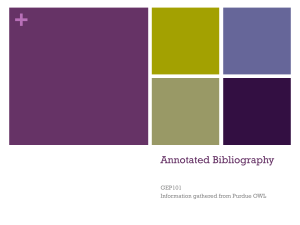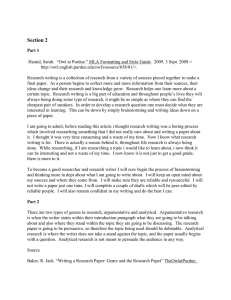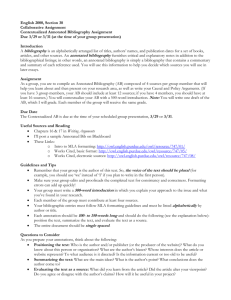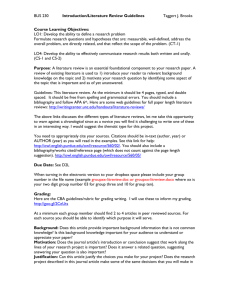Section 2 - WordPress.com
advertisement
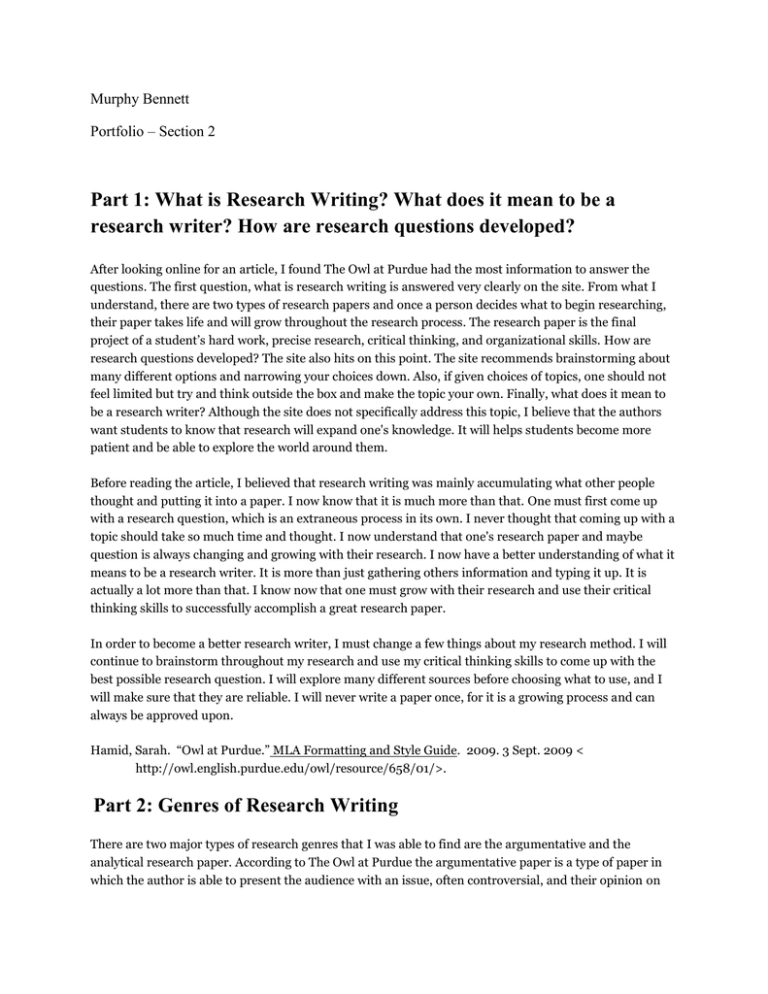
Murphy Bennett Portfolio – Section 2 Part 1: What is Research Writing? What does it mean to be a research writer? How are research questions developed? After looking online for an article, I found The Owl at Purdue had the most information to answer the questions. The first question, what is research writing is answered very clearly on the site. From what I understand, there are two types of research papers and once a person decides what to begin researching, their paper takes life and will grow throughout the research process. The research paper is the final project of a student’s hard work, precise research, critical thinking, and organizational skills. How are research questions developed? The site also hits on this point. The site recommends brainstorming about many different options and narrowing your choices down. Also, if given choices of topics, one should not feel limited but try and think outside the box and make the topic your own. Finally, what does it mean to be a research writer? Although the site does not specifically address this topic, I believe that the authors want students to know that research will expand one's knowledge. It will helps students become more patient and be able to explore the world around them. Before reading the article, I believed that research writing was mainly accumulating what other people thought and putting it into a paper. I now know that it is much more than that. One must first come up with a research question, which is an extraneous process in its own. I never thought that coming up with a topic should take so much time and thought. I now understand that one's research paper and maybe question is always changing and growing with their research. I now have a better understanding of what it means to be a research writer. It is more than just gathering others information and typing it up. It is actually a lot more than that. I know now that one must grow with their research and use their critical thinking skills to successfully accomplish a great research paper. In order to become a better research writer, I must change a few things about my research method. I will continue to brainstorm throughout my research and use my critical thinking skills to come up with the best possible research question. I will explore many different sources before choosing what to use, and I will make sure that they are reliable. I will never write a paper once, for it is a growing process and can always be approved upon. Hamid, Sarah. “Owl at Purdue.” MLA Formatting and Style Guide. 2009. 3 Sept. 2009 < http://owl.english.purdue.edu/owl/resource/658/01/>. Part 2: Genres of Research Writing There are two major types of research genres that I was able to find are the argumentative and the analytical research paper. According to The Owl at Purdue the argumentative paper is a type of paper in which the author is able to present the audience with an issue, often controversial, and their opinion on that issue. They do this in hopes of persuading the audience to agree with their stance, which many times are found in the thesis sentence of the paper. The analytical paper then is more of an information based paper in which the author does not give their opinion or stance, but rather is relaying all sides of the issue to the audience. Source Baker, R. Jack. "Writing a Research Paper; Genre and The Research Paper" The Owl At Purdue. 10 Sept. 2009 < http://owl.english.purdue.edu/owl/resource/658/02/.> Part 3: Reading Critically & Evaluating Sources Critical Reading for Critical Writing * First find the thesis of the paper, this is their reason for writing the paper * think not what facts are but what they mean concerning the subject matter * Be open minded, stand back and see exactly what they are saying, think about how you would say it Knott, Deborah. "Critical Reading Towards Critical Writing." University of Toronto. 15 Sept. 2009 < http://www.writing.utoronto.ca/advice/reading-and-researching/critical-reading> What is Critical Reading? *Do not try and memorize facts you will not get to critical thinking * When critical reading you not only read what the text says but also what it does with the facts and what it means by giving you the facts * Certain goals that one must accomplish ( examples find authors purpose and recognize bias) Kurland, Dan. “What Is Critical Reading.” Reading and Writing Ideas As Well As Words. 15 Sept. 2009 < http://www.criticalreading.com/critical_reading.htm> I found both articles to be very helpful in understanding critical reading more. I believe this will help me make more critical comments on my classmate’s blogs. I found the article that I found on the internet to be most helpful. It gave goals for a student to reach while reading. These goals are a very helpful start to understanding critical reading. Critically Analyzing Information Sources There are five main parts of the source that one should look at o Author o Date of Publication o Edit or Revision o Publisher o Title of Journal o One must next look over the content of the journal if they find that the source is reliable o If there is an abstract or preface, it is important to read that over first to see if the source is even going to help with your research Engle, Michael. “Critically Analyzing Information Sources.” Cornell University Library. 24 Sept. 2009 http://www.library.cornell.edu/olinuris/ref/research/skill26.htm Critically Analyzing Information Sources There are a couple main steps o Is there an author and what are his credentials o Look at date of publication, is it an out of date journal o Who is the publisher, many colleges publish and then these are usually scholarly journals o Now you must look at the content and see if it applies to your research o Consider if the content is biased or opinionated o Is the material primary research or secondary research o “Critically Analyzing Information Sources.” Texas A&M University. 24 Sept. 2009 http://library.tamu.edu/help/help-yourself/using-materials-services/critically-analyzinginformation-sources> I find that after looking at these two articles that the most important aspect is making sure the author is reliable. In both articles, the authors said that checking the credentials and date of publication and other aspects of without even reading the article is the first thing to do. I found this very interesting because I always go right for the content to see if I can use it. I guess it makes sense to check this entire section first though because if it can’t be used, why even read it right? I also realized that I need to look into the type of writing and how biased the piece is more. Most of my articles so far, I have just picked them out because when I typed my topic into EBSCO HOST they came up and after quickly skimming them, I thought they would work. I now see that I have a lot more work than I imagined and a lot more critical reading than I thought. All of these steps are extremely important to finding reliable and informational sources. In order to write a well written paper and a paper that is backed up by legitimate information, one must complete these steps, no matter how lengthy the process. Part 4: Understanding Formatting (MLA/APA/CMS) The Owl at Purdue The requirements for MLA formatting change almost yearly Using citations protects the writer from plagiarism There are a list of general guidelines that one should follow A few examples are to double space the header, one inch margins on all sides, and there should be a separate end notes page before your works cited page There is no cover page unless said otherwise by your instructor “Owl at Purdue.” MLA Formatting and Style Guide. 2009. 17 Sept. 2009 < http://owl.english.purdue.edu/owl/resource/557/01/>. A Writers Reference The writer must cite all direct quotations and also any ideas borrowed from a source This includes summaries and paraphrases, statistics and other specific facts Make sure the sources are credible Make sure your in text citation is cited correctly, there are many different ways to do so It is good to paraphrase ideas from a work so that your reader can better understand them, just make sure you cite the idea!!! Do not overuse quotations from other authors use your own ideas Hacker, Diane. A Writer’s Reference. 6th ed. Boston: New York, 2007. After reading the two articles, I have found that my experience using MLA is nowhere near perfect. There are many important facts that I have yet to learn before reading these. I am one hundred percent guilty of using too many citations in work. I thought before that a research paper is one where you just take work and put it together, now I understand that you have to put your own thought and meaning into the paper. It is VERY important to cite other authors work, even if you think that you had that idea, and you find someone else did, go ahead and cite them. It is better to be safe than sorry when it comes to plagiarism. I am very thankful for the book that Marlene has recommended and think that it will help me write a correct MLA formatted research paper without getting kicked out of IUP!!! Part 5: Creating a proposal and outline for a research paper Research Proposal The research proposal is one of the first parts of the research writing process. The proposal is your statement of what you want to do for your paper and how you are going to go about doing it. Also, it states why you are doing it and what you want to get from it. After writing the proposal, the professor can tell whether you work is going to be worth it. The proposal will give you a great start to forming your thesis, because you have many of the ideas that need to go into the thesis already down on paper. The proposal is not written without a little research done first. The student must pick a familiar topic, and look up as much information on it as possible. Then the student should pick what they believe is important to continue to research, and what things about the topic the readers of the paper should know more about. McGranaghan, Matthew. "Guidelines on writing a research proposal". 10 Sept. 2009. <http://www2.hawaii.edu/~matt/proposal.html> The page that I have found online to help me understand the proposal was very helpful. I have posted a link so others can use it to better their own. Research Outline There are four main steps to creating a organized and helpful outline. The first is identifying the topic. This is obviously important for your research. The next is identifying the main categories. This will be helpful in organizing the different types of research you did and the different questions that you asked in your research. The next two are creating a main category and creating subcategories. This will help one be more organized. UNIVERSITY OF WASHINGTON Psychology Writing Center http://web.psych.washington.edu/writingcenter/writingguides.html Part 6: Writing an Annotated Bibliography The annotated bibliography is a list of the sources, or some may call it a works cited, that one has used for a research paper. Each source has a short summer/description after it that the author has written. This summary includes a short summary, but also a few sentences from the author that describes why the source is relevant to the paper and/or the reliability of the source. The process is not an easy one for the annotated bibliography, but it help one be more organized and cite all the information they have used. First, one must read the different sources and highlight what is important to the paper. Next, one must cite the source on the anno bib page according to the correct MLA or APA format. Finally one must write the annotation. I found that the Cornell University website gives a good description of what an annotated bibliography should be. The site says, “Write a concise annotation that summarizes the central theme and scope of the book or article. Include one or more sentences that (a) evaluate the authority or background of the author, (b) comment on the intended audience, (c) compare or contrast this work with another you have cited, or (d) explain how this work illuminates your bibliography topic (Engle, Blumenthal, Cosgrave).Once these steps are complete, one will have an annotated bibliography that will help both the reader and author with understanding the purpose of the paper. Engle, Michael, Amy Blumenthal, and Tony Cosgrave. "How To Prepare An Annotated Bibliography." Cornell University Library. 19 Sept. 2009.<http://www.library.cornell.edu/olinuris/ref/research/skill28.htm> Part 7: Understanding Audience Writing For An Audience * create a common ground between you and your audience * do this by knowing who your audience is that you are writing for * also be aware of the audiences needs, this means that although you want to them to see what you are saying, you have to adapt to them enough that they want to continue reading your paper Flower, Linda. "Writing for An Audience." 15 Sept. 2009 <http://marlenharrison.com/images/flower_writing_for_an_audience.pdf> Choosing and Writing for an Audience *it is very important to know who your real audience will be (real meaning the people who will actually read your paper) because you do not want to say anything that will intentionally hurt anyone *if you do not have an audience in mind, your writing may be more broad than intended * also if you have an intended audience that is smaller, you may be able to write more personal and pick out the right questions to answer and how to word them * you may want to pull your audience in with a personal introduction, indicating you are talking to them personally Dr. Hale, Steven. "Choosing and Writing for An Audience." 15 Sept. 2009 <http://facstaff.gpc.edu/~shale/humanities/composition/handouts/audience.html> After reading the article given by Marlene, I was a bit confused about what the author meant when she said know what your audience knows and wants. I figured you just write and then whoever reads it, well just reads it. But after searching more articles, I believe that I understand better. You need to know who you intend on reading it, but at the same time think rationally and know who will more likely read it. Once you have those two groups in mind, it may be best to write to both throughout your paper. Also, you really need to make it somewhat personal so that your audience stays hooked. Part 8: Drafting and Revising Preparing to write and drafting the paper *Not everyone benefits from a very detailed outline but a scratch outline helps most people * if you have trouble with the introduction, move on and come back later * Avoid using language that comes straight from the assignment *avoid offering history of your process to find information Drafting is normally the most difficult part of a paper for me because I do not know where to start. With this paper however it was a little easier because the paper was split into four parts. As this document stated I started with an outline that helped me along the way. The introduction was hard but with the help of this document I was able to tweak it so it sounds better. Williams, Joseph. “Preparing to write and drafting the paper” University of Chicago Writing Program. 9 Dec. 2009. http://program.uchicago.edu/resources/collegewriting/preparing_to_write_and_drafting.htm Revising Drafts *when you revise look at it with a fresh, critical view * It is different than editing * Do not just fix commas and sentences * Wait awhile to go back to the draft * Check the focus of the paper With the week off from the paper, I found it easier to revise my paper when I needed to. I had a week to forget about my work that I had done, and focus on other things. This was very helpful like the article says. Also, I normally just edit my paper, but this time after reading the article I found that I needed to do more than that. I took some things out that sounded off and put in information that I feel I missed out on. Zinsser, William. “Revising Drafts”. The Writing Center, University of North Carolina at Chapel Hill. 9 Dec. 2009. http://www.unc.edu/depts/wcweb/handouts/revision.html Part 9: Peer Review and Feedback Responding – Really Responding – To Other Students Writings * Do not destroy all errors – you are not rewriting the paper *Know what the assignment is being written for * Know the state of drafting that the paper is in * Put comments in both the margins and leave a holistic paragraph at the end This article was very useful when peer editing. In high school when we were asked to peer edit, teachers would tell us just to fix any mistakes we found. This is very different than what the article said. After the peer editing process one of my group members came up to me and told me that my comments really helped her out. She even asked for me to edit it again. This article helped me edit that paper to the point where she wanted more advice. Straub, Richard. “Responding-Really Responding- To Other Students Writings.” 6 oct. 2009. http://marlenharrison.com/images/straub.pdf Part 10: Publishing Research Publishing * to find peer review select advance search whenever possible * use specific key words to find a journal you want * look for most recent journals * try and find peer review journals Right now I know that my paper is not publishable. Through this article and discussion in class, I found that each journal requires different things from the potential author. At first I was having a hard time finding a journal that my paper would fit in, but after reading this article I narrowed my search and was able to find some good education journals in which I could publish when my paper is ready. “Publishing” UniSA Library. 9 Dec 2009. < http://www.library.unisa.edu.au/research/publish.asp>
